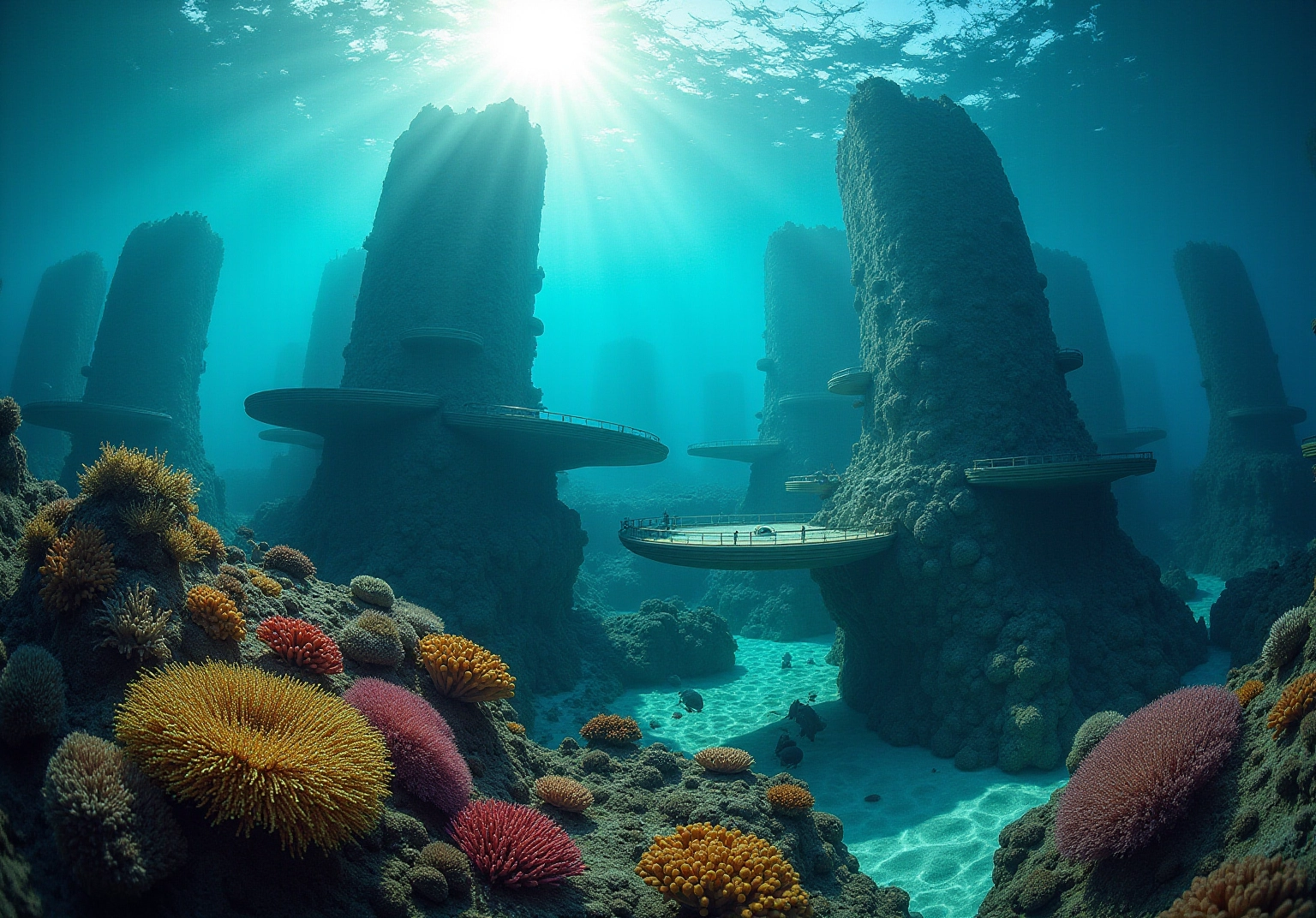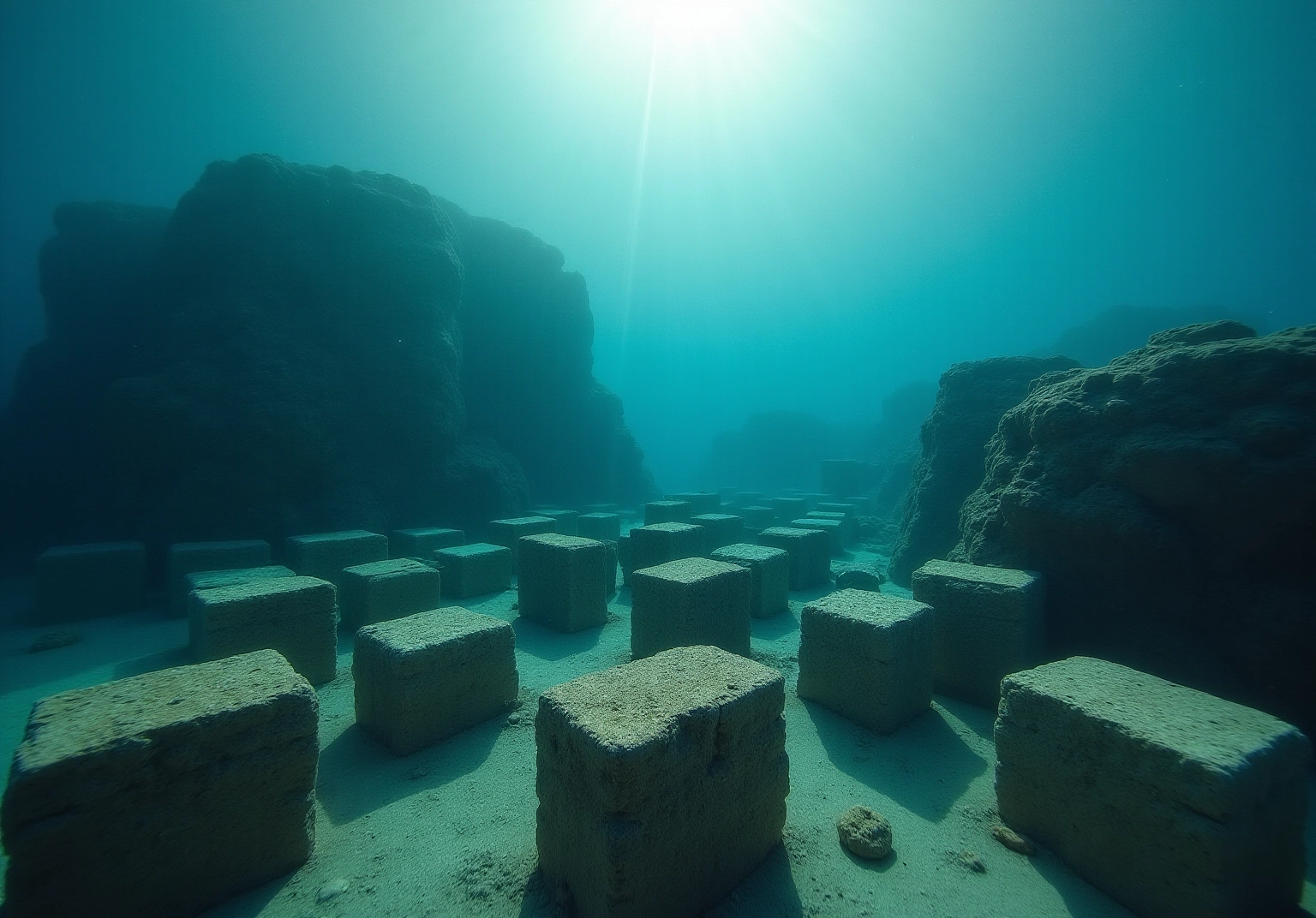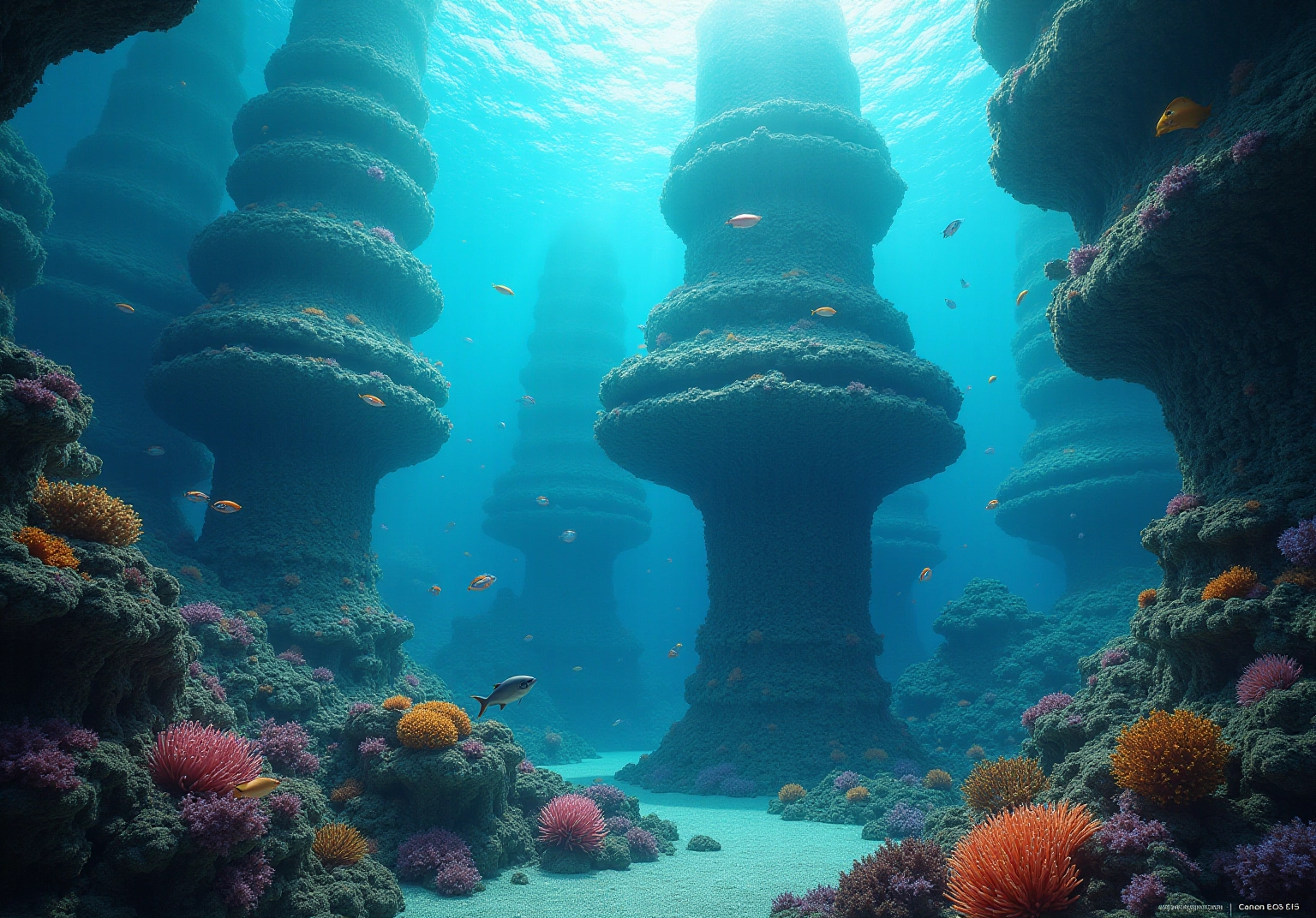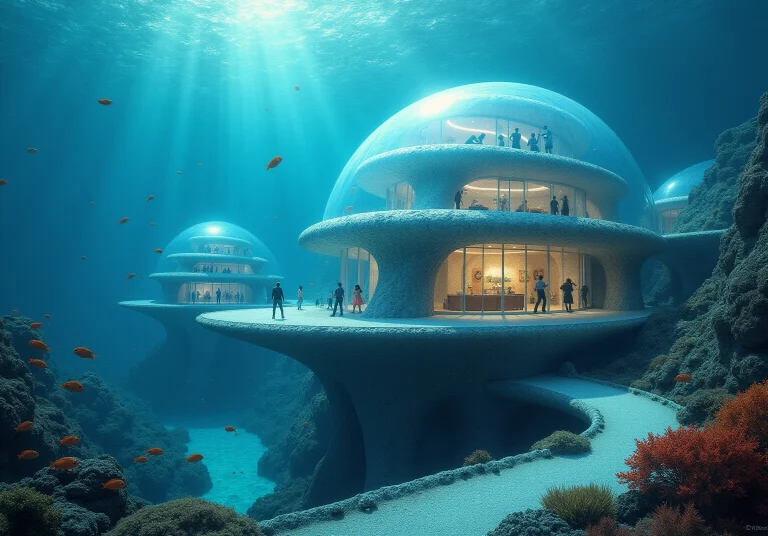Overview
Have you ever thought about underwater cities? They’re not just a fantasy; they offer some truly innovative solutions to big challenges like overpopulation and climate change! Imagine these submerged structures becoming habitats for future urban growth as sea levels rise. It’s fascinating to think about how they can protect coastal ecosystems while also serving as sustainable living spaces and research hubs.
Take Japan’s Ocean Spiral, for example. This modern project is a perfect illustration of how we can blend creativity with practicality. It’s exciting to see how these concepts can come to life, offering us a glimpse into a future where we can live harmoniously with our oceans. So, why not dive into the possibilities? There’s a whole world of underwater exploration waiting for you!
Key Highlights:
- Underwater cities are human-made structures beneath oceans, addressing challenges like overpopulation and climate change.
- Historical examples include Thonis-Heracleion and Pavlopetri, which provide insights into ancient civilizations.
- Rising ocean levels pose threats to urban areas, making underwater habitats increasingly relevant.
- Innovative projects like Aequorea and Ocean Spiral aim to create sustainable living spaces in aquatic environments.
- Underwater cities could protect coastal ecosystems and serve as research hubs for marine biology.
- By 2050, over 300 million people may be displaced due to rising sea levels, highlighting the urgency for solutions.
Introduction
Have you ever imagined what it would be like to explore underwater cities? The allure of these submerged metropolises captivates the imagination, offering a glimpse into a future where human ingenuity meets the depths of the ocean. From ancient ruins like Thonis-Heracleion to modern innovations such as Japan’s Ocean Spiral, these sites are not just historical wonders; they also hold potential solutions to contemporary challenges like climate change and overpopulation.
As rising sea levels threaten coastal communities, it’s a fascinating question to ponder: could these aquatic habitats provide a sustainable answer to urbanization while preserving our cultural heritage? Diving into the origins and significance of underwater cities reveals an exciting intersection of history, technology, and environmental stewardship. So, let’s embark on this journey together and discover what lies beneath the waves!
Define Underwater Cities: An Overview
Have you ever imagined what it would be like to live in cities under the sea? These incredible human-made structures, known as cities under the sea, are nestled beneath oceans and other bodies of water, blending creativity with the beauty of the ocean. Some, like Thonis-Heracleion in Egypt, have a rich history, having succumbed to rising ocean levels and natural disasters. Others are forward-thinking designs aimed at tackling modern challenges such as overpopulation and climate change.
Doflamingo raises an important point: if the water level rises by five meters, most urban cities could face flooding! This urgency makes the exploration of underwater habitats even more crucial. By 2025, technology has advanced significantly, leading to exciting projects like Aequorea, which is set to house up to 20,000 residents off the coast of Rio de Janeiro, and the Ocean Spiral, envisioned by the Shimizu Corporation, aiming to accommodate thousands at depths of 1,500 to 4,000 meters.
One fascinating example is the Eilat Coral World Observatory, showcasing the practical potential of submerged structures. It not only demonstrates the feasibility of aquatic habitats but also serves an educational purpose. Imagine the possibilities! These innovative habitats reflect our response to urbanization while embracing eco-conscious principles, designed to minimize environmental impact and provide resilient living spaces.
As we delve deeper into the concept of cities under the sea, it sparks conversations about the future of urban growth. We’re faced with the necessity for innovative solutions in light of rising ocean levels and climate change. So, what do you think? Are underwater cities the answer to our modern challenges?

Explore the Historical Development of Underwater Cities
The fascinating journey of cities under the sea dates back to ancient civilizations, with Pavlopetri, off the coast of Greece, being one of the oldest submerged locations and a true gem! Can you believe it was inhabited as early as 3500 B.C.? Over time, around 1000 BCE, this settlement gradually submerged due to a mix of natural disasters and rising ocean levels. Similarly, Thonis-Heracleion, a vibrant port settlement, was rediscovered in 2001 after it succumbed to the Mediterranean Sea around the 8th century AD. These archaeological treasures, known as cities under the sea, provide incredible insights into the social, economic, and cultural practices of their times.
The field of underwater archaeology has come a long way, allowing researchers to dive deeper into the mysteries of these lost civilizations. Imagine uncovering artifacts like stone blocks and anchors that illuminate ancient life and trade routes! Plus, the ancient cities under the sea in the Gulf of Cambay, which predate known archaeological artifacts by an astonishing 5,000 years, showcase the rich tapestry of sunken civilizations. Isn’t it amazing how advancements in marine archaeology continue to enhance our understanding of these remarkable sites? Let’s keep exploring together!

Assess the Significance of Underwater Cities Today
The importance of submerged metropolises today goes beyond mere historical fascination; they offer creative solutions to some of our most pressing global challenges! As climate change accelerates rising ocean levels, the idea of building new cities under the sea is becoming increasingly appealing. Can you imagine a world where coastal areas, projected to face significant flooding, could transform into cities under the sea that thrive? Recent studies suggest that by 2050, over 300 million people could be displaced due to rising sea levels. These habitats could provide sustainable living environments while protecting coastal ecosystems.
Take Japan’s Ocean Spiral project, for instance! This innovative concept envisions self-sufficient aquatic communities that harness renewable energy from ocean currents. How exciting is that? Moreover, these underwater locations could serve as research hubs for marine biology and environmental science, enhancing our understanding of oceanic ecosystems. As Kira Simpson wisely notes, “Creative solutions such as cities under the sea can help us adapt to the challenges presented by climate change while preserving our cultural heritage.”
Exploring these underwater realms, particularly the concept of cities under the sea, not only preserves cultural heritage but also ignites imaginative urbanization strategies to tackle environmental challenges. So, what do you think? Could submerged cities be the answer to our future living spaces? Let’s dive deeper into this fascinating topic together!

Conclusion
Exploring cities beneath the waves reveals a captivating mix of history, innovation, and a pressing need for sustainable solutions as we face climate change. These submerged metropolises, from ancient sites like Pavlopetri to modern marvels such as Japan’s Ocean Spiral, showcase our resilience and creativity in adapting to environmental challenges. The concept of underwater cities not only offers a glimpse into our past but also presents a forward-thinking approach to future urban living.
Throughout this journey, the historical significance of these submerged cities shines through, illustrating how they provide invaluable insights into ancient civilizations and their cultures. The discussion also touches on contemporary implications, highlighting the potential of underwater habitats to tackle pressing issues like rising sea levels and urban overpopulation. Imagine integrating eco-conscious designs and renewable energy sources—these innovative structures could redefine how communities thrive in harmony with the ocean!
As we grapple with the realities of climate change, the idea of underwater cities stands as a beacon of hope and ingenuity. By embracing this vision, we can preserve our cultural heritage while paving the way for sustainable living environments that protect both people and ecosystems. Engaging with the concept of submerged metropolises encourages us all to reflect on the future of urban living and the importance of finding creative solutions to the challenges ahead. So, what do you think? Are you ready to dive into this exciting exploration of our underwater future?
Frequently Asked Questions
What are underwater cities?
Underwater cities are human-made structures located beneath oceans and other bodies of water, designed to blend creativity with the beauty of the ocean.
What is the historical significance of some underwater cities?
Some underwater cities, like Thonis-Heracleion in Egypt, have a rich history and have sunk due to rising ocean levels and natural disasters.
Why is the exploration of underwater habitats becoming more urgent?
The exploration of underwater habitats is becoming more urgent due to the threat of flooding in urban cities from rising water levels, which could occur if the water level rises by five meters.
What are some examples of upcoming underwater city projects?
Upcoming underwater city projects include Aequorea, which will house up to 20,000 residents off the coast of Rio de Janeiro, and the Ocean Spiral, envisioned by the Shimizu Corporation, aiming to accommodate thousands at depths of 1,500 to 4,000 meters.
What is the Eilat Coral World Observatory?
The Eilat Coral World Observatory is a submerged structure that demonstrates the feasibility of aquatic habitats and serves an educational purpose.
How do underwater cities address modern challenges?
Underwater cities aim to tackle modern challenges such as overpopulation and climate change by providing innovative, eco-conscious living spaces that minimize environmental impact.
What discussions do underwater cities spark about urban growth?
The concept of underwater cities sparks conversations about the future of urban growth and the necessity for innovative solutions in response to rising ocean levels and climate change.


































